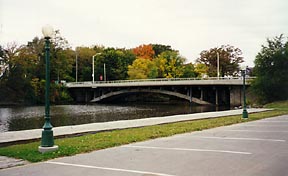
River Street Bridge

This long-span concrete arch carries River Street across the Iowa River in the city of Iowa Falls. Preceded by an earlier structure at this crossing, the existing bridge traces its history to 1921, when plans and specifications for the structure were drafted by Des Moines civil engineer James B. Marsh on behalf of the state highway commission. For this urban crossing, Marsh delineated a single open spandrel arch, with three massive arch ribs carrying a series of concrete columns. The bridge would be handsome in its simplicity, as observed by J.H. Ames, bridge engineer for the Iowa State Highway Commission, to a member of the Iowa Falls Community Club: "I am sure that you are going to be pleased with the type of construction that is proposed, as it will make a very artistic and substantial bridge." Moreover it would be far more stable than the earlier span. There was some disagreement among the city, the county and the state highway commission regarding the height and location for the proposed structure, but when the county suggested dropping the project altogether, the city reacted strongly. Local citizens actively supported the bridge, citing the important commercial value of the project. Eventually the residents prevailed in securing financial backing for the bridge's construction, and commissioners advertised for competitive bids in late spring of 1922. Awarded the contract that summer, the Welden Brothers Construction Company of Iowa Falls began work in July by demolishing the earlier bridge. Completed without incident in 1923 for the aggregate sum of $16,900, The Iowa River Bridge continues to carry steady traffic in its urban setting. The structure maintains good physical integrity, with 1958 widening of its deck and removal of the original guardrails electroliers as the most serious alteration.
The River Street location has been a pivotal one in Iowa Falls development. Initially a simple ford, the crossing was followed by a timber bridge, then an iron structure, then a 140-foot steel Pratt truss. As the fourth bridge here, the existing concrete arch represents the development of bridge technology here in Iowa. Its open spandrel configuration is unusual in Iowa. Relatively few such arches were ever built (all in urban locations like this one), and even fewer remain in use today. Designed by one of the state's foremost bridge engineers, it is an excellent example of its structural type.
 |
|||||||||||||